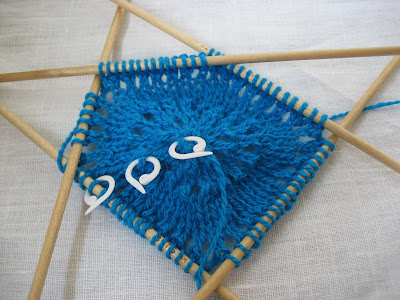I am contemplating making a sweater, my first sweater. Since I am a handspinner, this means starting by making the yarn, and since I spin on a drop spindle, this means spinning will take a lot of time.
My only work in progress right now is a
scarf. Call it the albatross, with apologies to Coleridge. Not because it hangs around my neck, as it's not done so it can't. Call it the albatross because the scarf lingers and reproaches me. I started
spinning the yarn at the end of August last year, I
cast on the K2P2 scarf in November, and it is summer now. For one of my projects to have so little progress and no resolution for that long, you have to believe that there is deep internal reluctance and conflict going on. Me, not the scarf. But due to the scarf, I assure you.
I really prefer resolution. The worst thing about Coleridge's poem is that part at the end where the ancient mariner says,
Since then, at uncertain hour,
That agony returns:
And till my ghastly tale is told,
This heart within me burns.
(
The Rime of the Ancient Mariner, 582-585) and you know that the poor blighter has to keep reliving the horrible experience because now he is a prophet and people must be told. And you had such high hopes a few lines before where he talks about running across that hermit, having a therapy session, and the tale leaving him free. I want my sense of resolution and completion.
Back to the sweater plans. I want to spin and make something grand and impressive that I can wear to the upcoming fiber festival. The partially-finished scarf is not it.
Even if the scarf were completely finished, I would still be unhappy with it. I tried it on, draping it around my neck with the needle carefully held out of the way. The fabric feels wrong. I don't know what the reason is but I can ignore the state of things no more. I am poised to frog this scarf. Ripping out the work will mean the reproachful scarf is gone, but even better, if I repurpose the yarn for a handspun, spindle-spun sweater, I won't have to spin so much.
Normally I want to spin as much as possible, but this is August and who knows how long it will take me to figure out how to knit a sweater to wear at the festival, never mind how long to spin for one.
The scarf is more than half as long as I am tall, and it is knit in K2P2 rib. In my scheming and plotting, I am trying to estimate how much stockinette sweater I could eke out of it. Add to that the two skeins that haven't been knit yet and the one skein that I ripped out for being slightly too thick, along with the remaining 20 some grams I haven't spun yet. I like doing inventory, yes, and marshaling my resources.
I am trying to anticipate handling a dye lot problem if I order more Ashland Bay merino in peacock. I am trying to imagine what people would say if I knit a sweater in both peacock and magenta handspun Ashland Bay merino. I have magenta in my stash. I love the colours and for all of my high school photos I alternated between wearing one or the other, but there is no denying that together they really knock your eye out. Perhaps I could put a line of dark navy to separate the blue and pink. Perhaps I should get a bit of navy and a lot more peacock and separate dye lots with the navy.
How much wool does a sweater take? I know the answer to that is, "It depends." I believe the way I'll get the answer is to start doing. For that I will need a pattern.












